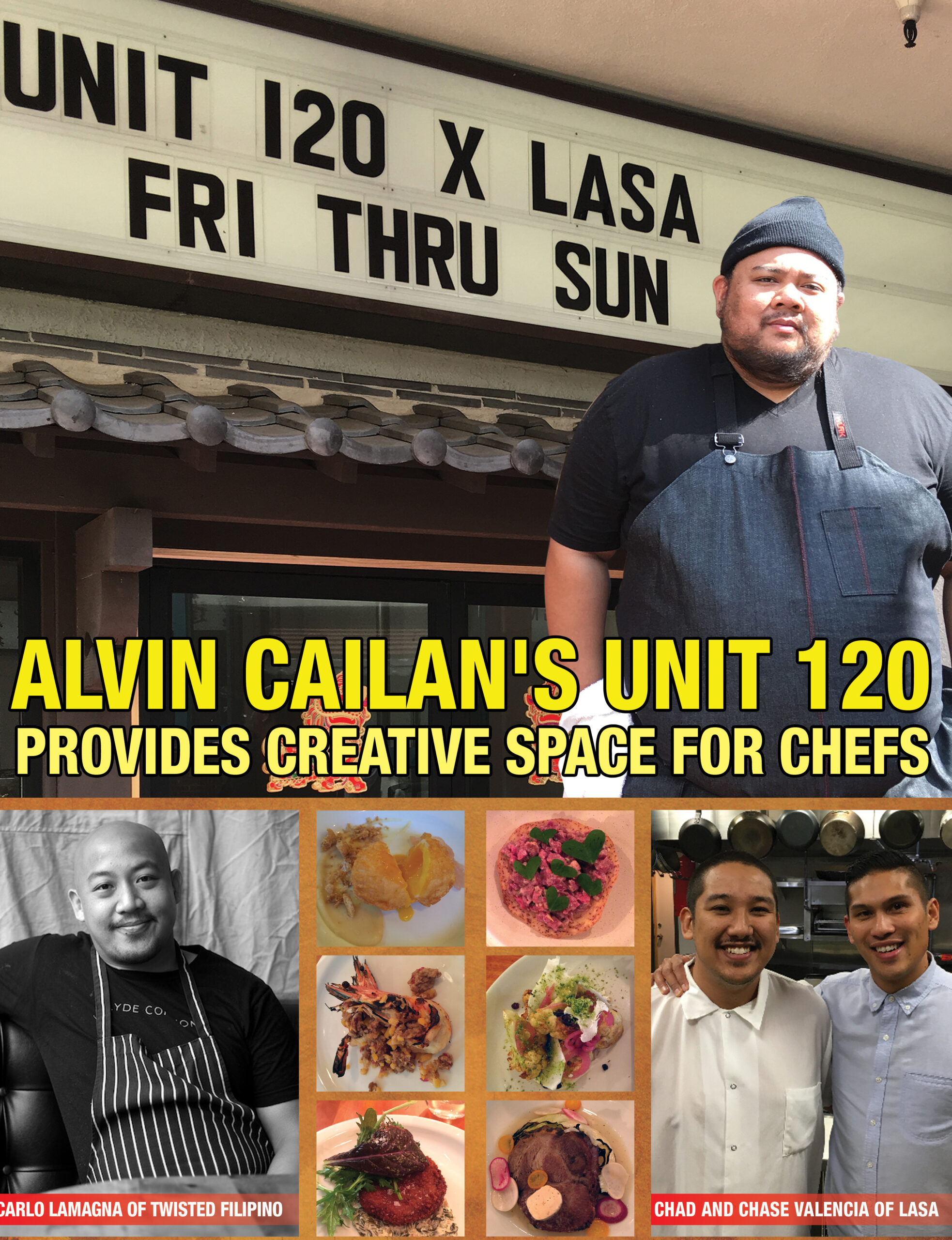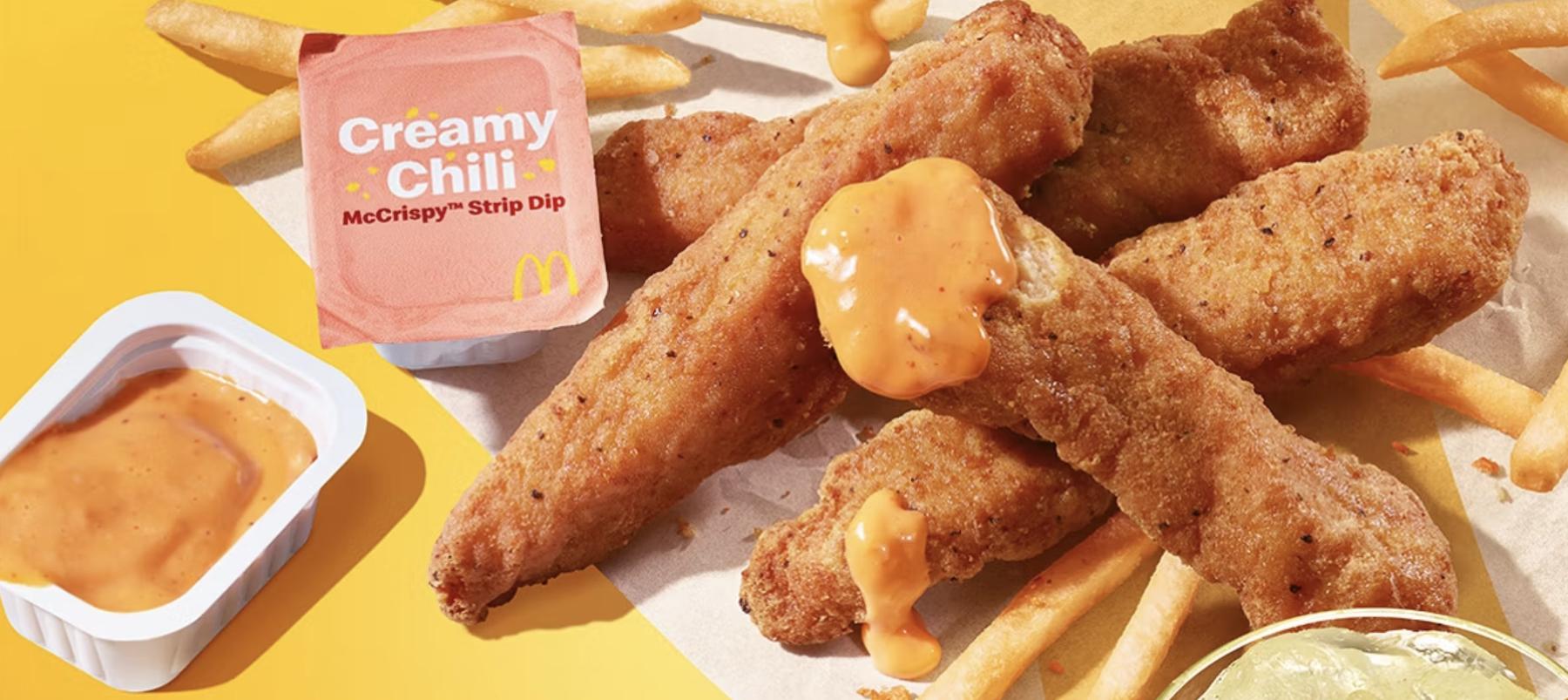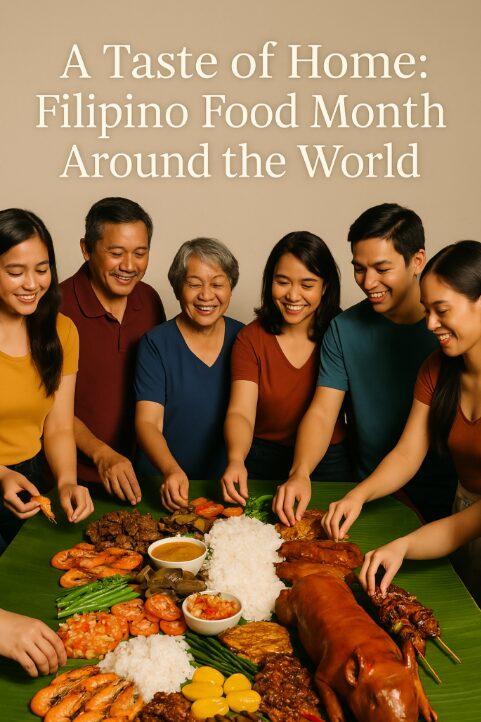
Driving through Los Angeles’ Chinatown, Far East Plaza on Broadway is one of those complexes that is easy to gloss over.
But with curiosity awakened and judgments of its outdated exterior aside, the two-story shopping center encases a culinary haven with options so abundant that multiple trips may be necessary. Inside, you can find Roy Choi’s Chego, Andy Ricker’s Pok Pok Phat Thai, Ramen Champ, artisanal ice cream at Scoops and decades-old Ten Ren’s Tea Time, to name a few.
Then there is newcomer Amboy, a takeout window serving up Filipino barbecued items that adds to the global foodie galore. During a weekday lunch, it’s common to see individuals eating cuts of pork belly from banana leaves or a vegan lentil stew evoking the flavors of kare-kare (traditionally an oxtail stew with thick peanut sauce).
Next door sits Unit 120 with signage that resembles an old-school theater, promoting the latest pop-up dinner to occupy the spot. If you’re hesitant to make reservations, you’ll miss a fleeting meal from local and visiting chefs, including Filipino Americans cooking in major cities.
These two aforementioned establishments are the latest productions of Fil-Am chef Alvin Cailan and his passionate pursuit to make Filipino cuisine more prominent and accessible.
Though a few miles away from Historic Filipinotown, there is perhaps no better place to continue the burgeoning Filipino Food Movement than in Chinatown, Calian argued, given the area’s foot traffic.
“A lot of people are now looking at this place as a destination for really great food,” he said. “Serious people who care about food are here, so people understand what we’re trying to do.”
An Amboy’s take on Filipino barbecue
Keeping up with Cailan since he graced the MDWK Magazine cover late last summer has been an uphill race. With so many ideas that could become the next best food trend, his plate is always full.
For starters, the widely popular Eggslut (the food truck-turned breakfast sandwich counter at Grand Central Market in Downtown which he founded) is slated to open locations in Venice Beach and the Cosmopolitan Hotel in Las Vegas sometime this year. He has since sold Ramen Champ to new owners, only to occupy a space downstairs at Far East Plaza for Amboy and Unit 120.
“I wanted to run something Filipino that I’ve been testing, which is Amboy,” Cailan told the Asian Journal on a recent afternoon after the takeout spot finished its service for the day.

Borrowing the nickname his grandmother bestowed on him, Amboy (“American boy”) is a befitting metaphor for what Cailan’s lunchtime undertaking is all about: Filipino food guided by the culinary training and influences acquired as a second-generation Filipino American.
“It’s not fusion, but it’s more like we grew up in Southern California and we like to grill,” he said. “We love to eat vegetables that are grown local. It’s California-style Filipino food.”
From 11 am to “whenever we run out” (usually around 3 pm), Cailan said, Amboy presents a straightforward menu with everything under $10.
“We’re keeping it a small price point because as much as I would love to charge hipster prices, I know how…Filipinos are and I want them to give the most bang for their buck,” he noted.
Meats like chicken (slow roasted with inasal glaze), pork shoulder, pork belly and steak and seasonal seafood are served inihaw (grilled), paired with white or brown rice and a tomato-cucumber salad with patis (fish sauce) vinaigrette.
One of the standouts is the pork belly — crunchy on the outside, yet soft without being too chewy — which undergoes a thorough multi-step process that includes brining, air drying and braising. With all that effort, it’s a surprise that the end result only comes with an $8 cost.

For vegetarians/vegans or those who want non-meat dishes, choose among the vegetables sautéed adobo style (kabocha squash and spinach stir up pinakbet flavors) or the legumes section of the menu (each $2) with kaldereta (Spanish-inspired chickpeas in roasted bell pepper tomato sauce), kare-kare (cannellini beans in a rich peanut sauce) and munggo (shiitake mushroom broth fortified with ginger), all traditionally meat-based stews that are presented in a relatively healthier manner.
“[The menu] has a mix of how I vision Filipino food, but…on an everyday basis. A lot of Filipino food has bases that are pork fat, but to me, as much as I love it, it’s not sustainable,” Cailan explained.
Influenced by street food culture, all of the items, which are made to order, are wrapped in butcher paper (binalot style) and banana leaves to awaken the recognized Filipino flavors.
Despite the potential vulnerability to criticism (i.e. the usual ‘that’s not how lola cooks it’ comparison), the overall reception to Amboy has been positive among Filipinos and non-Filipinos alike.
“We gave [a customer] a whole grilled pompano and he said he was transported to Boracay…that’s really our goal,” Cailan continued. “We want people to eat it and say that it’s just like Filipino food, but it doesn’t look like Filipino food. It’s not like your usual suspects…It’s something we’ve put a lot of effort into to look different, but still feels familiar.”
But beyond Amboy’s imprint in the movement, Cailan takes it a step further with Unit 120, a creative culinary incubator that is a breeding ground and test kitchen for culinary talent.
LASA’s residency at Unit 120
Inside Unit 120, the minimalist decor, wooden furniture and waiting area that feels like a friend’s living room all contribute to the unpretentious, homey vibe — even if the chefs who use the kitchen are among the highly trained and most experienced in the industry.
“I also wanted to help incubate restaurants and concepts…because of the constant trend of chefs who are looking to open a restaurant [and] who have all the talent in the world, but don’t necessarily have the capital to. If I had that opportunity, I totally would’ve done it instead of partnering with other people,” Calian said. “This is a place where people can see if their business is even worth doing.”
For brothers Chase and Chad Valencia*, finding a permanent home for their LASA (’taste’ in Tagalog) concept is the endgame.
After meeting at a NextDayBetter event last year, Cailan approached the brothers with a proposal to operate LASA every weekend at his new incubator, without having to invest in their own brick and mortar.=
“Chad and I are completely thankful for the opportunity Alvin has given us at Unit 120. He could’ve picked any other concept, but he had a belief in us after one meal and one exchange. He provides us more than a space – he provides mentorship and support,” Chase Valencia said.
Added Cailan, “I really want them to have their own restaurant, but I want them to do it the right way because they’re a great representation of what the Filipino Food Movement is. Chase and Chad are both very focused and yet, they are very aware of who they are and what they represent…They have so much pride in what they do and how they carry themselves. I want them to make all of the mistakes here without having to invest hundreds of thousands of dollars in a restaurant. And it’s translating [because] they’re busy every night.”
Since 2013, the Valencias have served dinners at Highland Cafe and the Elysian once a month, captivating diners with Filipino-inspired cuisine driven by the seasonality of Southern California’s farmers’ markets. The reservations were hard to score, oftentimes, selling out within minutes of going live.
But with LASA’s residency at Unit 120, the dinners are now three days a week (Friday to Sunday), giving a fair chance to those who never got to savor in their meals previously.
“We’ve matured because we had to focus and tighten our business and execution from a creative standpoint…in order for it to work three nights a week and to sustain wages and the means to go on in our everyday lives. It’s a learning process and it’s been an incredible one,” Chase said.
Since January, LASA has welcomed on average 120 diners each weekend, with a four-course, pre-fixe menu (prepared by Chad Valencia and sous chef Nico de Leon) that rotates every four weeks.

Recently, the menu included: beef tartare (marinated in calamansi kosho aioli atop a taro tostada, sprinkled with wood sorrel locally foraged); caramelized cauliflower with red onion and currant atchara paired with a vinegar yogurt; for the main course, a slow-roasted pork collar complemented with charred cabbage, fermented turnips, kumquat and bagoong butter; and finally, a take on champorado (chocolate rice pudding) topped with winter citrus pinipig (glutinous rice) and sesame granola and blood orange slices.
Previous versions presented items like crispy duck arroz caldo, pancit egg noodles and pear and kamote ginataan.
In addition to the gustatory factor, LASA has an educational component to it, as evidenced by the way the menu is written. For instance, having the Tagalog names of the dishes becomes a point of conversation, especially among non-Filipino customers.
“Our goal is also to educate diners about our food and our cuisine,” Chase said. “It is something that I worked with our team on to know the ingredients…what do they mean and what is the influence from that.”
Even with LASA’s resounding success, the brothers still see room for growth and call on continued community support to help them eventually get to their own place.
“The next phase after this would be a brick and mortar…There’s definitely a level of confidence coming from us and even our diners too. Our diners have been so supportive…there’s a sense of [wondering] what’s going to happen next,” Chase said.
Twisted Filipino
Aside from LASA, Unit 120 opened up to a series of Filipino chefs, kicking off with A’postrophe by Charles Olalia (former executive chef of Patina who opened Rice Bar, a Filipino rice bowl counter also in Downtown’s Jewelry District).
Carlo Lamagna, executive chef of Clyde Common in Portland, followed the week after with a two-night dinner.
“He really opened my eyes as far as the potential of what our generation is creating for Filipino food,” Cailan said.
At $75 a pop, Twisted Filipino presented a seven-course meal that didn’t skimp on the flavors.
Tokneneng (fried soft boiled duck egg paired with pickled shallots, garlic puree, chicken skin chicharron) started off the night — something with strong and with bang, Lamagna said, to really hit the richness of Filipino cuisine. The kinilaw (razor clams with calamansi and coconut custard) played on a sweet and sour duality and served as a palate cleanser. Sugpo, two grilled prawns with ground longanisa and Meyer lemon relish, was a take a land and sea dish. Next came the dinakdakan, head cheese served with pickled ramp aioli and mustard greens. Though not for the faint-hearted, it was made like a crab cake to make it more digestible. For the last savory course, lechon baka (roasted beef short rib) was presented atop bagoong fried and mango herb relish.

Lamagna, who was born and raised in the Philippines, crafted the menu that fuses the “many influences and obscure ideologies of Filipino food and [his] refined culinary training.”
What followed was a slice of Brazo de Mercedes (though cut more like a napoleon) made with a coconut meringue, candied cashew butter and vanilla anglaise. Lastly, a chocolate truffle modeled after kopiko coffee candy to bring the meal to a close.
“If it brings back a memory for a diner, then I’m hitting my mark,” shared Lamagna. “This is a way to reconnect with Filipino culture. I love and always will love Filipino food.”
Even if guests missed the first two Filipino chefs, Unit 120 has two more opportunities.
Ria and Matt Wilson, who introduced lunch program Wild at Canelé in Atwater Village, are scheduled to have a one-night-only dinner on Wednesday, March 2. Maynard Llera, sous chef of Bestia, is closing out the series with Filipino-inspired dishes from the restaurant on Tuesday, March 8.
“We’re ending with Maynard because he has put so much love and effort into what he wants to do for this dinner. Next year, we’re going to do it again with a whole new round of chefs,” Cailan said.
Along with the flourishing pop-up dining scene is the grow- ing popularity of Filipino cuisine among adventurous diners who are always looking for something different. Such experiences keep the Pinoy culinary traditions alive.
“When any race eats our food, we want them to say, ‘Hey, why…haven’t I been eating Filipino food before?’ Because we’re not reinventing the wheel or taking away anything from the first generation of Filipino-American restaurants,” Cailan said, adding “What we’re doing here is so vital to have our community represented…We want people to come out to Chinatown and really enjoy what we’re trying to do. We’re working hard to make it an experience.”
*The Valencia brothers and LASA were on the MDWK Magazine cover in Dec. 2014. LASA is serving dinner every Friday to Sunday from 6 pm to 10 pm. Reservations are highly encouraged and can be made at www.lasa-la.com. For more information about upcoming pop-up dinners at Unit 120, please visit www.unit120.com.






